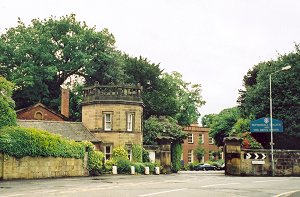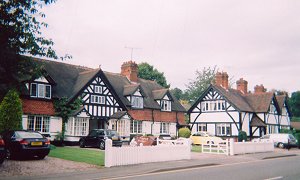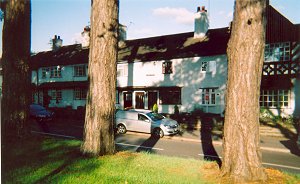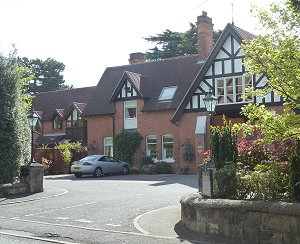Lodge to Rock House, Grove Lane,
Tettenhall Wood.
 |
Rock House is now called "Duntally" and can be seen
in the back of the picture. Dr. T. E. Hastings lived
in Duntally around 1942. His practice was at 26
Waterloo Road. |
Lodge/Gatehouse to Tettenhall Towers, Wood
Road, Tettenhall
|
Tettenhall Towers was the home of Colonel Thomas
Thorneycroft. His father was G. B. Thorneycroft,
ironmaster, of the Shrubbery and Swan gardens Ironworks
in Walsall Street, which was established in 1857 and
used the Emu brand. Colonel Thorneycroft sold the
ironworks and spent much of his time and money improving
the Towers, probably including this gatehouse, which
mimics the shape of the tower on the main house. |
 |
Compton Hill Lodge, The Holloway, Compton
 |
This was the Lodge to the house known as Compton Hill.
The land to the house extended from Grove Lane down to
the Swan Pub. It included Oakleigh and a few
cottages.
William and Mary E. Bruford lived here around 1900. He
was involved in mining of sand at Compton Holloway. He
may have been the W. Bruford owned Wolverhampton
Brewery, Market St. Wolverhampton. An advertisment of
his company can be seen in Walsall Red Book 1876. |
|
William Bruford died about 1923. The house and land was
sold in 1932 on
the death of Mrs Mary E. Bruford. It eventually became
a housing estate. |
Bantock Park Estate Houses, Finchfield Road
|
The owner of Bantock House, Thomas Bantock, was born
in Scotland, the son of a gamekeeper.
A self-made man of great integrity, he came to
Wolverhampton and thrived in the transport industry.
He took the tenancy of Bantock House about 1866 and
bought it in 1885.
The estate houses have been sold and modernsied
recently (2008). |
 |
The Lodge to Chequerfield House, Stubbs Road
 |
The Lodge is at the top of Stubbs Road, near the
Penn Road.
Chequerfield House may have been named after the
fruit of the wild service tree, which were known as
chequers. Victor Emmanuel Hickman lived in the
house around 1901.
The house was demolished in the 1960s, and
Chequerfield Drive is where it once stood.
Chequerfield Street is still there. |
Wightwick Manor Lodge, Wightwick Bank
|
This medieval building was the original Wightwick
Manor (and is now known as the Old Manor House).
When the present Manor was built by the Manders this
building was restored and used as the lodge to the new
Manor.
The original Wightwick Hall had been held by the
Wightwick family since the thirteenth century. Richard
Wightwick was a co-founder of Pembroke College, Oxford. |
 |
Wightwick Estate House, Bridgnorth Road,
Wightwick
 |
These were estate houses for Wightwick Manor.
The Manor was designed by Edward Ould and the interior
had designs by William Morris, C. E. Kempe and L. G.
Shaffrey. It was built by Theodore Mander and
completed about 1887. |
Coach House at Oak Hill, Finchfield.
|
The coach house, facing Oak Hill, is part of the
house facing Castlecroft Road.
According to a plaque on the gate post the house was,
in 1855, St. Catherine's Ladies Finishing School. |
 |
Lodge to Goldthorn Court, Goldthorn Hill
 |
The lodge stands on the corner of Goldthorn Hill and
Goldthorn Road. The house itself was behind the
lodge on Goldthorn Road. Its site is now occupied
by modern housing. |
Tyninghame Cottages, Codsall Road,
Tettenhall
|
According to residents, these were estate cottages
to Tyninghame House, which still stands, at the end of
Tyninghame Road, on the other side of Codsall Road. |
 |
Lodge
at Highgrove Estate, Wood Road, Tettenhall
 |
This is the
Lodge/Gatehouse to what was a house called White Lodge.
An 1890 map shows White Lodge but as yet no lodge or
outbuildings. Later on, a 1913 map shows outbuildings
built round a courtyard with a large carriage entrance
facing the road. They seem to be a lodge and stables.
The Highgrove Estate was
built in 1985 and the houses and estate office around
the courtyard seem to be built on the same footprint as
the old courtyard. The lodge, and what is now the
estate manager's office, seem to be the only parts of
the old buildings which are now left. |
|
The name Highgrove was
selected by the first residents of the estate without
intending any reference to the Grove, which was the old
house to the East of White Lodge, on whose grounds
Maythorn Gardens now stands.
In 1911 White Lodge was owned
by Charles Shaw (born Theodore Frederick Charles
Edward Shaw in 1859) who was managing director of John
Shaw & Sons Ltd. of Wolverhampton, a member of
Wolverhampton Council, a captain in the South Staffs
Regiment, and Liberal MP for Stafford from 1892-1910. He
lived there with his wife
Emily, and became a baronet in 1908. He attended
Tettenhall College and Balliol Oxford, and married Emily
White Bursill in 1900 at St Marks, Piccadilly. They had
two daughters, Vera Stafford Shaw and Brenda Winifred
Shaw. They moved to Ascot (Charters)
and then on to Harewood in Sunninghill, where he died in
1942
leaving £18,000 in his will. (I am indebted
to information re Shaw from Julie (sassychassis.co.uk)
which she discovered whilst researching past owners of
her 1938 Rolls Royce Wraith). Thanks must also go to
David Clare.
By 1922 a W. Jackson was
living at White Lodge and by 1942 a Mrs Jackson is still
living there. Her daughter was a Mrs Norgrove.
Between 1968 and 1982 White
Lodge was owned by John Charles Dennis Somerville and
his wife, Patricia. Mr. Somerville owned the Crown
Nail Works in Commercial Road, Wolverhampton, which was
an offshoot of the family nail works in Scotland. His
father died at the age of 60 so Mr. Somerville decided
to sell up in Scotland and move permanently to
Wolverhampton . They had three children and were very
happy at White Lodge. The stables had a service cottage
. A swimming pool was built in this area.
Arthur White of Midland
Counties Dairies lived round the corner in Ormes Lane
and owned the land next to White Lodge on the corner of
Wood Road and Ormes Lane. On this land he built The
Folly; according to Mrs. Somerville it was a very
smart, cutting edge, one storey house.
Mr. Somerville and Arthur
White sold up at the same time. White Lodge (the house)
and the Folly were demolished; the lodge and gatehouse
were not demolished but incorporated into the new estate
of Highgrove. The Somervilles moved to Perton Ridge and
Mr. Arthur White moved to Eynsham Court, Clifton Road,
Tettenhall.
Mrs. Somerville has kindly
sent me a copy of a painting of White Lodge which she
had commissioned. I am indebted to her for information
about White Lodge
I am also indebted to Mr. A.
Davies who first drew my attention to this lodge. |

A painting of the White Lodge by C. C. Hall, 1972.
Courtesy of Mrs Patricia Somerville.
Any further identifications
of gatehouses and lodges in Wolverhampton would be gratefully
received. Please email me at: stonechat2018@gmail.com
|

